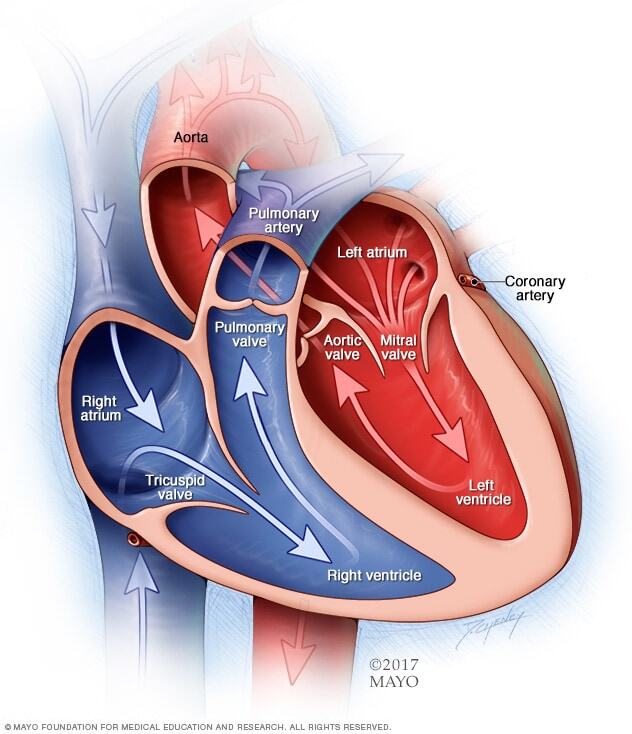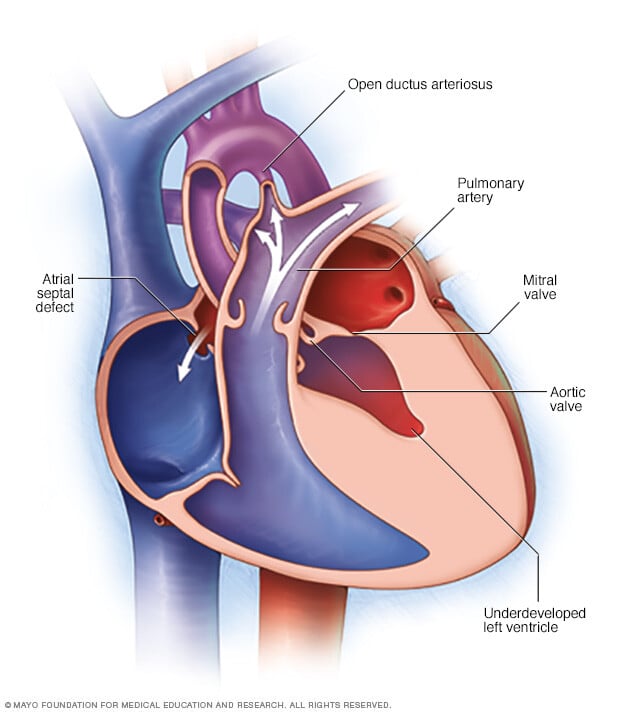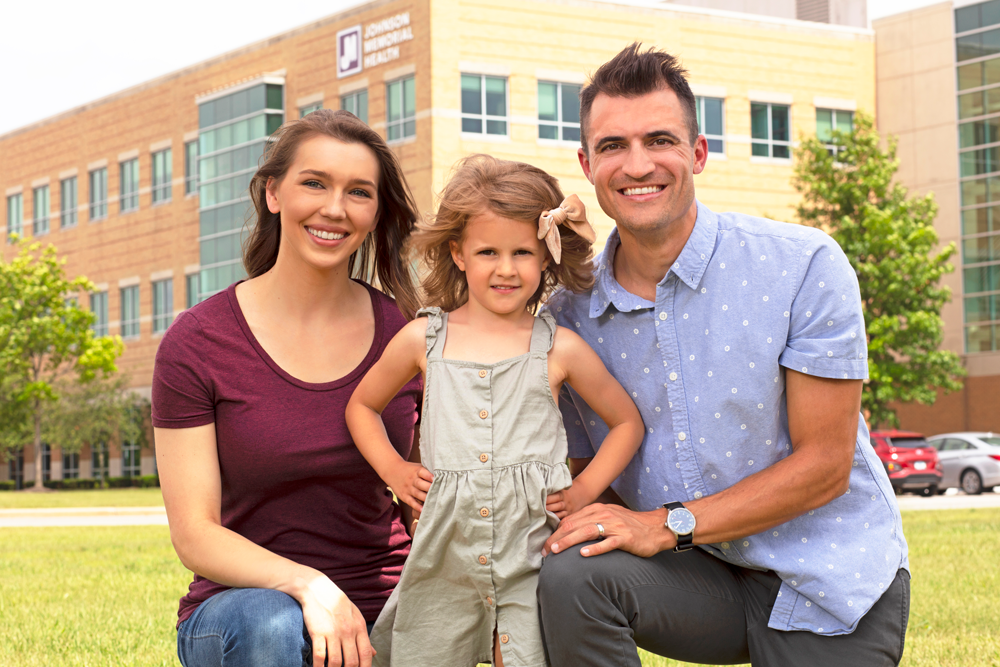Hypoplastic left heart syndrome
Overview
Hypoplastic left heart syndrome (HLHS) is a rare heart condition that a child is born with. That means it's a congenital heart defect. In this condition, the left side of the heart doesn't develop fully and is too small. So it can't pump blood well. Instead, the right side of the heart must pump blood to the lungs and to the rest of the body.
Treatment for hypoplastic left heart syndrome may include medicines, heart surgery or a heart transplant. Advances in care have improved the outlook for babies born with HLHS.
Symptoms
Babies born with hypoplastic left heart syndrome (HLHS) usually are very sick soon after birth. Symptoms of HLHS include:
- Blue or gray skin, lips or fingernails. Depending on skin color, these changes may be harder or easier to see.
- Rapid, difficult breathing.
- Poor feeding.
- Cold hands and feet.
- Weak pulse.
- Being more drowsy or less active than is typical for most babies.
Without treatment, a baby with this condition may go into shock. Symptoms of shock include:
- Cool, clammy skin that can be pale or lips that can be blue or gray.
- A weak and rapid pulse.
- Breathing that may be slow and shallow or very rapid.
- Dull eyes that seem to stare.
When to see a doctor
Get emergency medical help if your baby has:
- Changes in skin or nail color.
- Trouble breathing or fast breathing.
- Weak pulse or rapid pulse.
- Cool clammy skin.
Causes


Hypoplastic left heart syndrome (HLHS) happens in the womb when a baby's heart develops. The cause isn't known. Gene changes may play a role.
In hypoplastic left heart syndrome, the left side of the heart hasn't grown enough so it does not develop fully. It can't properly send blood to the body. In HLHS, the following areas of the heart are too small:
- The lower left heart chamber, called the left ventricle.
- The body's main artery, called the aorta.
- The heart valves on the left side of the heart, called the aortic and mitral valves.
After birth, the right side of a baby's heart usually pumps blood both to the lungs and to the rest of the body. The blood passes through an opening called the ductus arteriosus. This opening, also called a vessel, connects the pulmonary artery directly to the aorta. The oxygen-rich blood goes back to the right side of the heart through a natural opening between the right chambers of the heart. The opening is called the foramen ovale.
The ductus arteriosus usually closes after the first day or two of life. When that happens, the right side of the heart has no way to pump blood to the body. The left side of the heart takes over this job.
But in babies with hypoplastic left heart syndrome, the left side can't pump blood well. So they need medicine to keep these connections open and keep blood flowing to the body until they have heart surgery.
Risk factors
People who have a child with hypoplastic left heart syndrome (HLHS) have a higher risk of having another baby with this or a similar condition.
There are no other clear risk factors for hypoplastic left heart syndrome.
Complications
With proper treatment, many babies with hypoplastic left heart syndrome (HLHS) survive. But they do need many surgeries and can have less energy and other challenges. Complications of HLHS may include:
- Getting tired more easily during sports or other exercises.
- Irregular heartbeats, called arrhythmias.
- Fluid buildup, called edema, in the lungs, stomach area, legs and feet.
- Not growing well.
- Developmental conditions related to the brain and nervous system.
- Need for more heart surgery or a heart transplant.
Prevention
There's no way to prevent hypoplastic left heart syndrome. If you were born with a heart condition, talk with a heart doctor and genetic counselor before getting pregnant.
Diagnosis
To diagnose hypoplastic left heart syndrome (HLHS), a healthcare professional examines the baby and listens to the baby's heart. The healthcare professional may hear a sound called a heart murmur. Rushing blood flow causes this sound.
Tests
Tests used to find hypoplastic left heart syndrome (HLHS) in the baby before or after birth may include:
- Pregnancy ultrasound. A routine ultrasound exam during the second trimester of pregnancy usually can tell if the baby has HLHS.
- Echocardiogram. This test uses sound waves to make pictures of the heart. It shows how blood flows through the heart. It can be used after a baby is born to diagnose hypoplastic left heart syndrome. If a baby has HLHS, the test might find that the lower left heart chamber and heart valves are small. The body's main artery, called the aorta, also may be small.
Treatment
A baby born with hypoplastic left heart syndrome (HLHS) needs urgent treatment. Treatment can include many surgeries or a heart transplant. Medicines and other therapies are used to manage symptoms before heart surgery.
Talk with your child's healthcare professional about treatment options for your child.
If hypoplastic left heart syndrome is found before birth, healthcare professionals usually recommend giving birth at a hospital with a cardiac surgery center.
Medications
The medicine alprostadil (Prostin VR Pediatric) is used to keep the ductus arteriosus open. It typically closes in all babies soon after birth. But in babies with hypoplastic left heart syndrome, the ductus needs to stay open so that blood can go to the rest of the body.
Therapies
While waiting for surgery or a heart transplant, a baby with hypoplastic left heart syndrome may be given medicine and have these treatments:
- Breathing help. Babies who have trouble breathing may need help from a breathing machine called a ventilator.
- Fluids through a vein. A baby might receive fluids through a tube inserted into a vein. These are called intravenous (IV) fluids.
- Feeding tube. Babies who have trouble feeding or who tire while feeding can be fed through a feeding tube.
Surgery or other procedures
Most children with hypoplastic left heart syndrome need several surgeries.
- Atrial septostomy. This treatment uses tubes called catheters and a balloon to make or widen an opening between the heart's upper chambers. It lets more blood flow between the upper two chambers of the heart. This treatment is done if the foramen ovale closes or is too small. Babies born with a hole in the heart, called an atrial septal defect, might not need atrial septostomy.
Other surgeries can make separate pathways to get the correct blood flow to the body and lungs. The surgeries are done in three stages.
-
Norwood procedure. This surgery is often done within the first two weeks of life. There are various ways to do this treatment.
Surgeons rebuild the aorta and connect it to the heart's lower right chamber. Then they add a tube called a shunt to provide the lungs with blood. The surgeons may use one of two types of tubes. One type of tube connects the body's main artery to the arteries leading to the lungs. Those are the pulmonary arteries. The other type of tube goes from the right lower heart chamber to the pulmonary arteries. This treatment lets the right lower heart chamber pump blood to both the lungs and the body.
Sometimes, a mixed, also called hybrid, procedure is done. Heart surgeons place a stent in the ductus arteriosus to maintain the opening between the pulmonary artery and the aorta. Then they place bands around the pulmonary arteries to reduce blood flow to the lungs. They also make an opening between the upper chambers of the heart.
After the Norwood procedure, a baby's skin often is still slightly still slightly blue or gray. This is because oxygen-rich and oxygen-poor blood continue to mix within the heart. The blue or gray color may be easier or harder to see in some babies. Once a baby has this treatment, the odds of survival can go up.
-
Bidirectional Glenn procedure. This tends to be the second surgery. It's usually done when a child is between 4 and 6 months of age. It involves removing the first shunt and connecting the large vein that drains blood from the head and arms to the pulmonary artery. Now the lungs receive blood from the vein instead of the shunt. The large vein is called the superior vena cava.
This surgery lessens the work of the right lower heart chamber by letting it pump blood mainly to the aorta. It also lets most of the oxygen-poor blood returning from the body flow directly into the lungs. After this treatment, all the blood returning from the upper body flows to the lungs. So blood with more oxygen is pumped to the aorta to supply organs and tissues throughout the body.
-
Fontan procedure. This surgery usually is done when a child is between 3 and 4 years of age. The surgeon creates a path for the blood from the lower legs to flow directly into the pulmonary arteries. The vessel involved is called the inferior vena cava. The pulmonary arteries then send the blood into the lungs.
The Fontan procedure lets the rest of the oxygen-poor blood returning from the body flow to the lungs. After this surgery, there's little mixing of oxygen-rich and oxygen-poor blood in the heart. So the skin should no longer look blue or gray.
- Heart transplant. Many babies with hypoplastic left heart syndrome need a heart transplant. (8) Children who have heart transplants need to take medicines for life to so that their bodies don't reject the donor heart.
Follow-up care
After surgery or a transplant, a baby needs lifelong care with a heart doctor trained in congenital heart disease to watch for complications. Your child may need further treatment or other medicines for these complications.
Some children may need to take antibiotics before certain dental or other procedures to help prevent infections. Ask your child's healthcare professional if your child needs preventive antibiotics. Some children also may need to limit physical activity.
Follow-up care for adults
Adults who were born with hypoplastic left heart syndrome (HLHS) need to see a heart doctor trained in congenital heart disease in adults. Recent advances in surgical care have helped children with HLHS grow into adulthood. So it's not yet clear what challenges an adult with the heart condition might have. Adults need regular, lifelong follow-up care to watch for changes in the condition.
People thinking about becoming pregnant should talk with their healthcare professionals about pregnancy risks and birth control options. Having hypoplastic left heart syndrome raises the risk of:
- Heart and blood vessel problems during pregnancy.
- Miscarriage.
- A baby being born with a congenital heart defect.
Coping and support
It can be challenging to live with hypoplastic left heart syndrome (HLHS) or to care for a baby with the condition. These tips may help:
-
Seek support. Ask family members and friends for help. Caregivers need breaks. Talk with your child's heart doctor, also called cardiologist, about support groups and other types of help. And think about meeting with a counselor or therapist if you often feel anxious, sad or too stressed.
If you're a teen or an adult with HLHS, ask your healthcare team if there are support groups for people your age with congenital heart disease. It can be helpful to talk to other people who share your challenges.
-
Keep health records. Write down your or your baby's diagnosis, medicines, surgery and other treatments. Include the dates of treatment and the name and phone number of the doctor or surgeon. Also note emergency contact numbers for healthcare professionals and hospitals. Include a copy of surgery reports in your records.
This information helps you keep track of the care received. It is helpful for any new healthcare professionals who don't know your or your child's health history. This information also is helpful when your child moves from pediatric care to adult cardiology care.
- Talk about your concerns. Talk with your child's healthcare team about which activities are safest for your child. If some are off-limits, encourage your child in other hobbies. If you are an adult with hypoplastic left heart syndrome, ask your healthcare professional about activities you can do



